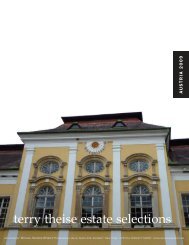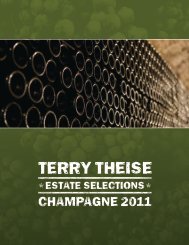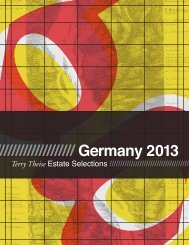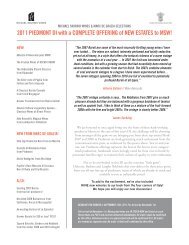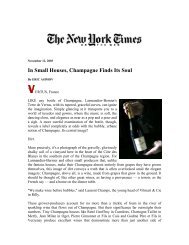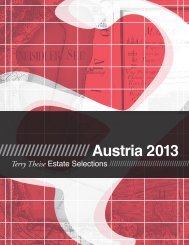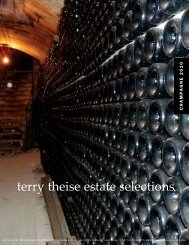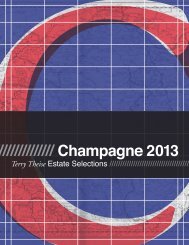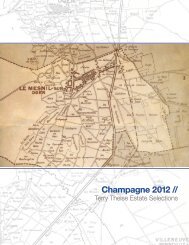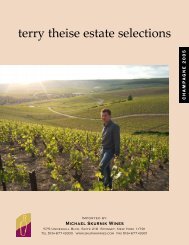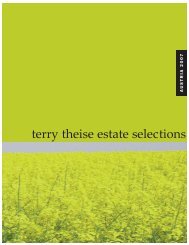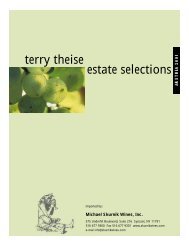German Catalog 2006 USE THIS ONE.qxp - Michael Skurnik Wines
German Catalog 2006 USE THIS ONE.qxp - Michael Skurnik Wines
German Catalog 2006 USE THIS ONE.qxp - Michael Skurnik Wines
You also want an ePaper? Increase the reach of your titles
YUMPU automatically turns print PDFs into web optimized ePapers that Google loves.
96<br />
nahe wines<br />
It is a joy to labor lovingly on behalf of what I feel to be the loveliest Riesling wines on the face<br />
of the earth.<br />
You know, the Rhineland is really quite compact. You can get to the Nahe in a half-hour from<br />
the Rheingau, a half-hour from the Rhinehessen, an hour from the Pfalz, and an hour from the<br />
Mosel. Yet the Nahe is the forgotten acre just out of view, trilling beyond earshot in its winsome,<br />
lonely corner. Especially after the soaring scenery of the Mosel, the dreamy Nahe is almost narcotically<br />
soothing. It’s still, and intimate, and stirs the soul as it calms the nerves.<br />
Things feel astir on the Nahe these days. Mr. Dönnhoff has brought acclaim to his region, and<br />
a number of excellent growers are in the slipstream of that attention; Schönleber, Hexamer,<br />
Schäfer-Fröhlich, not to mention Mr. Diel, who is in nobody’s slipstream. A case could be made that<br />
no other <strong>German</strong> wine region has the Nahe’s concentration of outstanding estates in a similarly<br />
small area. The region is also especially lovely for wine<br />
pilgrims because it remains quiet and authentic. In contrast<br />
to the Pfalz, where every weekend from Easter to<br />
harvest is cram-a-lama with gawkers and slug-it-downers.<br />
At least there’s one place on earth wine lovers can go<br />
to get away from it all. There are no billboards here, no<br />
wine trains, no neon “DEGUSTATION-VENTE” or “VIS-<br />
The least of Nahe wines are refined<br />
and delicate, with a feline grace. The<br />
best of them are the beating heart of<br />
Riesling, as fine as it can possibly be.<br />
ITEZ LES CAVES!” signs. You can hear a breeze rustling<br />
through trees in the next orchard before it reaches the one<br />
in which you’re sitting. There’s a constant clamor of<br />
birds. Signs by the side of the road warn of frog crossings.<br />
You wouldn’t drive fast even if you could.<br />
The least of Nahe wines are refined and delicate,<br />
with a feline grace. The best of them are the beating heart<br />
of Riesling, as fine as it can possibly be: intricate, searchingly<br />
complex, with hypnotically shimmering overtones<br />
of flavor that can stir you to a point between perplexity<br />
and awe. Good Nahe Riesling is slim but not scrawny,<br />
with a succulence that seems to magically glaze the<br />
palate, coolly elegant and spectrally multifaceted. If the<br />
pure flavor of wine interests you in and of itself, these<br />
wines will give you as much delight and absorption as<br />
wine ever can.<br />
There are four basic soil types in the Nahe. Each gives<br />
its own kind of wine. Slate does what it always does; the<br />
Nahe variant has more middle, almost like a super rich<br />
Saar wine. Rotliegend, our old friend from Nierstein, gives<br />
smoky, tangy wines along Nierstein lines but more compact,<br />
with an ethereal redcurrant taste and a cool marbeline<br />
feel. Loam and clay are the plebians, mostly planted to the<br />
commoner varieties, though even these varieties are more<br />
fetchingly graceful along the Nahe. Finally the volcanic<br />
soils with the exotic names: porphyry, melaphyre, gneiss,<br />
rhyolite, give the world’s most spellbinding white wine,<br />
Riesling at an impossible pinnacle of fire and grace.<br />
Blackcurrant, honeysuckle, raspberry, a heavenly host of<br />
flavors astonishingly differentiated and an almost prismatically<br />
filigree.<br />
Several years ago, while I was with a group of customers,<br />
we had a nice alfresco lunch along the Nahe with<br />
Helmut Dönnhoff. After we finished eating, people<br />
began rising from the table and stretching. Helmut set<br />
out on a walk between rows of vines. I followed. We were<br />
in the Oberhäuser Brücke, a small, one hectare site along<br />
the river. It is longer than it is wide, and I followed<br />
Helmut as we walked, heads bent, silently. Finally after<br />
Good Nahe Riesling is slim but not<br />
scrawny, with a succulence that seems<br />
to magically glaze the palate, coolly<br />
elegant and spectrally multifaceted.<br />
having walked perhaps a hundred yards, we reached the<br />
end of the row. Helmut stopped, and turned to face me.<br />
He was grinning from ear to ear, and by then, so was I.<br />
We returned to the group and I beckoned them to follow<br />
me. The exercise was repeated, this time with eight of<br />
us walking one behind the other—we looked like a chain-



